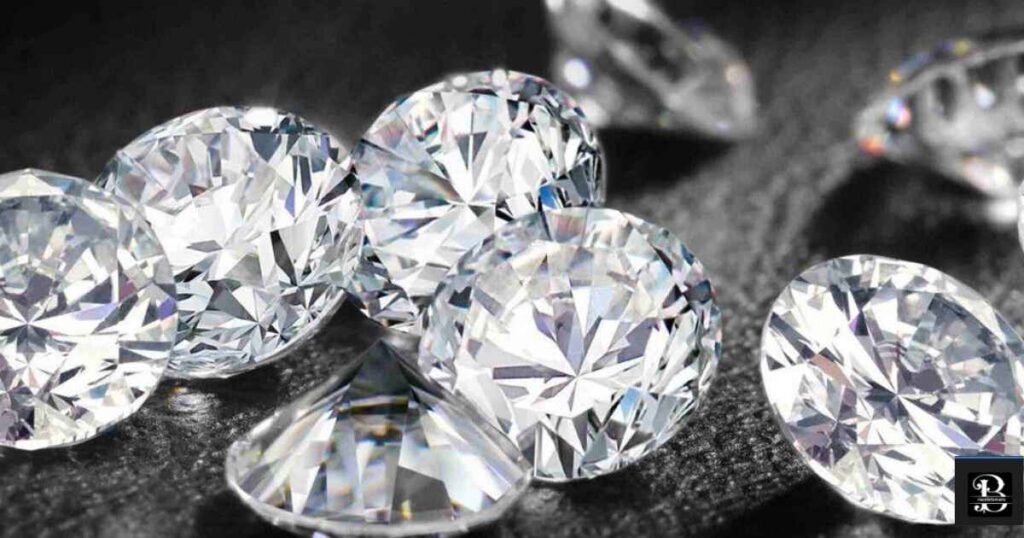How Rare Are Diamonds? Debunking Diamond Myths
How Rare Are Diamonds? This question has intrigued gem enthusiasts and skeptics alike for decades. The crystal uniqueness of these precious stones has long been touted by the jewelry industry, but is their scarcity fact or fiction? As we delve into the world of gemstone frequency and mineral abundance, we’ll uncover surprising truths about diamond availability.
From the depths of gem mines to the precision of lab-grown diamonds, we’ll explore the factors that influence diamond pricing and market demand. We’ll examine the role of clever marketing in shaping our perceptions and the real geological processes behind diamond formation.
Prepare to have your assumptions challenged as we separate diamond facts from gemstone misconceptions in this sparkling journey through the diamond trade.
What are diamonds?
Diamonds are more than just pretty rocks. They’re carbon atoms arranged in a specific crystal structure, formed deep within the Earth under intense pressure conditions and heat exposure. This unique geological process gives diamonds their incredible hardness and sparkle.
Natural diamonds take millions of years to form, while lab-grown diamonds can be created in just weeks. Both types have the same physical and chemical properties, making them indistinguishable to the naked eye. The jewelry industry now offers both options to consumers, shaking up the traditional diamond business.
Why Are Diamonds so Valuable?

Diamonds have held our fascination for centuries, but their value isn’t just about their beauty. Their cultural significance and industrial uses play a big role in their worth.
Read This Blog:
A rich history
Diamonds have a heritage that stretches back thousands of years. Ancient civilizations believed they held magical powers, and royalty coveted them as symbols of strength and wealth. The tradition of diamond engagement rings really took off in the 1930s, thanks to some clever advertising.
The magic of marketing
The De Beers corporation changed the game with their “A Diamond is Forever” campaign. They turned diamonds into must-have symbols of love and commitment. Suddenly, everyone wanted a diamond ring to pop the question. Talk about successful branding!
Mining is costly
Getting diamonds out of the ground isn’t cheap. Exploration, extraction, and environmental considerations all add up. Companies spend millions just to find promising sites, and then there’s the expensive equipment and skilled labor needed for mining. These costs get passed on to consumers, contributing to diamond prices.
What Stones Are More Rare Than Diamonds?
While diamonds are special, they’re not the rarest gems out there. Let’s look at some truly scarce stones:
Benitoite
This deep blue gem is only found in San Benito County, California. Its rarity and unique color make it a favorite among collectors.
Alexandrite
This color-changing stone looks green in daylight and red under artificial light. It’s incredibly rare, with only a few known deposits worldwide.
Emeralds
High-quality emeralds without inclusions are actually rarer than diamonds. The finest emeralds can command higher prices than diamonds of similar size.
Burma Ruby
Rubies from Myanmar (formerly Burma) are considered the cream of the crop. Their deep “pigeon blood” red color is unmatched.
Kashmir Sapphire
These velvety blue sapphires from India are so rare that they’re mostly found in museums or high-end auctions now.
Diamond Myths Debunked

Let’s bust some common misconceptions about diamonds:
Myth: Mined Diamonds Are Rarer Than Lab-Grown Diamonds
Actually, more mined diamonds are produced annually than lab-grown ones. In 2020, about 142 million carats of natural diamonds were mined, compared to only 7 million carats of lab-grown diamonds.
Myth: Diamonds Are Expensive Because They Are Rare
The high price of diamonds isn’t just about scarcity. It’s more about controlled supply and clever marketing. Major players in the diamond industry have historically managed supply to keep prices high.
Myth: There Aren’t Many Diamonds Left in the World
We’re not running out of diamonds anytime soon. In 2020, global diamond reserves were estimated at 1.2 billion carats. Plus, new technologies are helping us find more deposits all the time.
Myth: Higher Carat Diamonds Are More Valuable Than Lower Carat Weight Diamonds
Size isn’t everything when it comes to diamonds. A smaller diamond with excellent clarity, color, and cut can be worth more than a larger stone with poor qualities. It’s all about the balance of the 4Cs: carat, cut, clarity, and color.
Myth: Diamonds Are the Most Valuable Gem
While diamonds are valuable, they’re not always the priciest stones. Rare rubies, emeralds, and sapphires can fetch higher prices per carat than diamonds.
Myth: Lab-Grown Diamonds Aren’t Valuable
Lab-grown diamonds have the same physical properties as natural diamonds and are gaining acceptance in the jewelry market. While they’re generally less expensive than mined diamonds, they still hold value and are becoming increasingly popular.
Why Are Diamonds Valuable?
Despite not being the rarest gems, diamonds still command high prices. Here’s why:
All work and no play
Creating a beautiful diamond takes serious skill. Gem shaping and crystal polishing are art forms that require years of training. Master cutters can spend days on a single stone, carefully planning each facet to maximize its brilliance.
Also Read This Blog:
What Is Liquid Diamonds: Discover The Fascinating Science Behind It
What about lab diamonds?

Lab-grown diamonds are shaking up the industry. They’re chemically identical to mined diamonds but come with a smaller price tag and environmental footprint. Many consumers, especially younger ones, are drawn to their ethical and sustainable appeal.
The Michelle
Let’s look at a popular lab-grown diamond product:
| Feature | The Michelle |
| Carat Weight | 1.5 |
| Cut | Round Brilliant |
| Color | F |
| Clarity | VS1 |
| Price | $3,500 |
This lab-grown diamond offers similar quality to a mined diamond at about 30-40% less cost. It’s an appealing option for budget-conscious shoppers who still want the diamond look and durability.
Conclusion
How Rare Are Diamonds? As we’ve uncovered, the answer isn’t as straightforward as the jewelry industry might have us believe. While high-quality diamonds aren’t as common as pebbles on a beach, they’re not the rarest precious stones either. The perceived scarcity of diamonds is largely a product of controlled supply, clever marketing, and our cultural attachment to these sparkling gems.
From natural diamonds formed over millions of years to lab-grown alternatives created in weeks, the diamond market is more diverse than ever. The true value of diamonds lies in their physical properties, cultural significance, and the emotions they represent. Whether you choose a mined diamond, a synthetic stone, or an alternative gemstone, what matters most is the meaning behind your choice.
As gemstone knowledge evolves and consumer perceptions shift, the diamond business continues to adapt. In the end, the rarity of diamonds is as multifaceted as the stones themselves.
FAQs
Are diamonds rarer than gold?
No, gold is rarer than diamonds because carbon, which forms diamonds, is more abundant than gold on Earth.
Are diamonds rarer than emeralds?
Yes, emeralds are generally considered rarer than diamonds due to their unique geological formation and scarcity of high-quality specimens.
Why are diamonds so special?
Diamonds are unique due to their individual characteristics and are the hardest natural substance, making them highly durable.
What Stone is the rarest?
Painite is the rarest gemstone, with only a few high-quality pieces discovered worldwide.
Why is diamond very expensive?
Diamonds are expensive due to their rarity, mining difficulties, durability, and the four C’s—cut, clarity, color, and carat.

Amara Rosewood, with 8 years of expertise in bracelet design, is the creative force behind BraceletsWare. Her passion and skill converge in each piece, crafting timeless accessories that redefine style.






